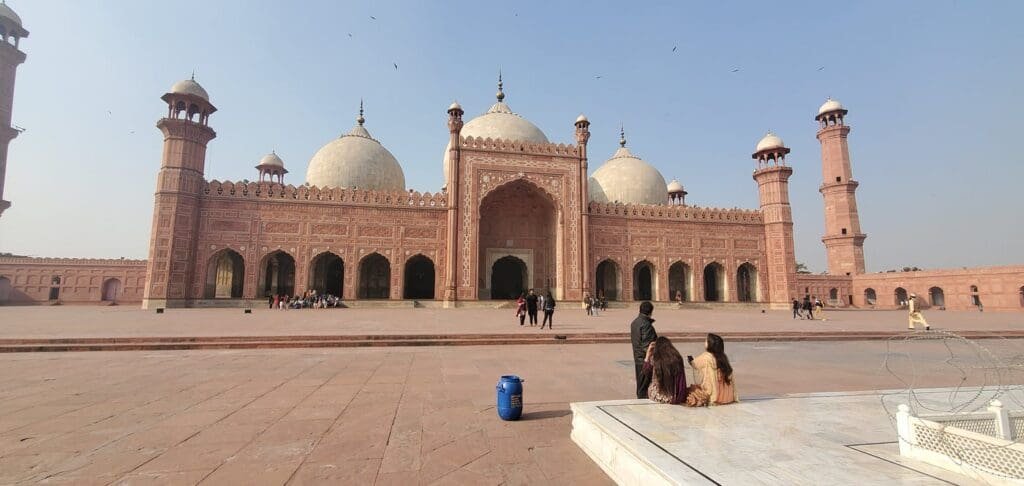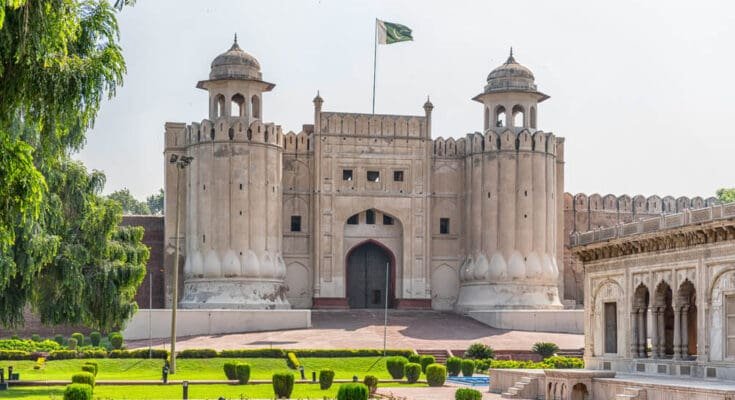Royal Fort’) i, nestled in the heart of Lahore, serves as a resplendent jewel in Pakistan’s rich history, showcasing the nation’s profound architectural prowess. Acknowledged and honored with the prestigious UNESCO World Heritage Site designation, this magnTheificent fort stands as a testament to the cultural and historical tapestry woven through the ages in the region.
Lahore Fort: A Jewel in Pakistan’s History
Constructed during various periods,
the Loh-Kot”,) i has witnessed the rise and fall of empires, each leaving its unique imprint on its grand structure. The fort’s architectural marvels encompass a fusion of Mughal, Sikh, and British influences, rendering it a captivating mosaic of diverse historical eras.
The fort’s strategic location and formidable design have bestowed upon it a pivotal role in shaping the course of Pakistan’s history. From being a symbol of Mughal power during the reign of Emperor Akbar to serving as the residence of Maharaja Ranjit Singh, the founder of the Sikh Empire, the Royal Fort’) i i has been a silent witness to the ebb and flow of dynasties.
Walking through the intricately adorned halls and courtyards, visitors can marvel at the exquisite craftsmanship that adorns the fort. The Sheesh Mahal, or Palace of Mirrors, is a prime example of the delicate artistry that defines Mughal architecture. The Naulakha Pavilion and the Badshahi Mosque, situated adjacent to the fort, further enhance the splendor of this historical complex.
Beyond its architectural magnificence
, the Lahore Fort resonates with stories of political intrigue, cultural flourishing, and the convergence of diverse influences. The fort’s significance extends beyond its physical structure, encapsulating the spirit of resilience and endurance that characterizes the people of Pakistan.

In contemporary times
, the Lahore Fort stands not only as a cherished historical landmark but also as a beacon for cultural preservation and heritage appreciation. Efforts to conserve and restore the fort ensure that future generations can continue to explore and appreciate the rich tapestry of Pakistan’s past, as narrated by the walls and corridors of this timeless masterpiece.
The Lahore Fort, a true gem in Pakistan’s historical tapestry, has its roots deeply embedded in the Mughal era. Initiated by the visionary Emperor Akbar in the 16th century, the fort stands as a testament to the Mughal architectural brilliance that flourished during this period. Its inception marked the beginning of a legacy that would be further enriched by subsequent Mughal rulers, including Jahangir and Shah Jahan, each contributing their own distinctive embellishments to transform the fort into a symbol of unparalleled grandeur and imperial power.
The Mughal origins of the Lahore Fort are evident in its meticulous design and layout, reflecting the architectural finesse characteristic of the era. The fort was strategically positioned, not just as a defensive stronghold, but also as a manifestation of the Mughal emperors’ authority and opulence. The initial foundations laid by Akbar were expanded upon by his successors, with Jahangir introducing elements of Persian influence, and Shah Jahan infusing his signature style marked by intricate marble inlays and stunning domes.
Under Jahangir’s reign, the fort witnessed the addition of the renowned Sheesh Mahal, or Palace of Mirrors, a masterpiece of craftsmanship that exemplifies the luxurious aesthetic tastes of the Mughal rulers. Meanwhile, Shah Jahan, the visionary behind the iconic Taj Mahal, left an indelible mark on the Lahore Fort with the construction of the stunning white marble Moti Masjid (Pearl Mosque) and the iconic Alamgiri Gate.
The Lahore Fort, therefore
, became not just a seat of power but a canvas upon which the evolving Mughal artistic and architectural expressions unfolded. The structures within the fort complex reflect a harmonious blend of indigenous influences and those drawn from the wider Islamic world, creating a unique architectural language that is distinctly Mughal.
As one traverses the corridors of the Lahore Fort, the Mughal legacy comes alive
, with each arch, dome, and courtyard echoing the grandeur of a bygone era. The fort’s significance extends beyond its physical form; it serves as a living testament to the cultural and historical richness that has shaped the identity of Pakistan. Today, the Lahore Fort stands not merely as a historical relic but as a vibrant narrative etched in stone, inviting visitors to immerse themselves in the captivating saga of Mughal splendor and the enduring spirit of a nation.
READ ALSO : The English Scientist and the Pakistani Gol Jalebi
The Lahore Fort,
standing proudly as a witness to the passage of time, has observed the ebb and flow of numerous dynasties, each contributing to its rich historical tapestry. Notably, the fort played a pivotal role during the era of the Sikh Empire and the British Raj, with each dynasty leaving an indelible imprint that shaped the complex’s narrative and mirrored the dynamic shifts in the political and cultural landscape of the Indian subcontinent.
During the zenith of the Sikh Empire,
the Lahore Fort became the seat of power for Maharaja Ranjit Singh, the charismatic ruler who unified the Sikh territories in the early 19th century. The fort, once resonating with Mughal grandeur, now bore witness to the Sikh influence, marked by architectural additions and modifications. Ranjit Singh’s rule brought about changes in the fort’s usage, transforming it into a symbol of Sikh sovereignty.
However, the British Raj heralded a new chapter in the fort’s history.
With the annexation of the Punjab region in 1849, the Lahore Fort transitioned from being a symbol of Sikh power to becoming a strategic stronghold for the British colonial administration. The British, recognizing the historical significance of the fort, undertook restoration efforts and made alterations to suit their administrative needs. This period saw the juxtaposition of British military infrastructure within the Mughal and Sikh architectural elements, creating a unique fusion that reflected the changing rulership.
The Lahore Fort,
therefore, stands as a silent witness to the shifting tides of power and the unfolding drama of dynastic changes. The juxtaposition of Sikh and British influences within the fort’s walls serves as a visual testament to the complex interplay of historical forces that have shaped the trajectory of the Indian subcontinent.
As one explores the corridors and courtyards of the Lahore Fort,
the layers of history become palpable. The fort’s stones whisper tales of sovereignty, resistance, and adaptation, encapsulating the essence of the diverse cultures and ruling powers that have graced the region. Today, the Lahore Fort stands not only as an architectural marvel but as a living chronicle of the intricate dance between dynasties, revealing the resilience and adaptability that define the historical narrative of the Indian subcontinent.
Expanding upon the Lahore Fort, a Jewel in Pakistan’s history and architectural marvel,
the Sheesh Mahal stands out as a captivating testament to Persian-inspired design. This palace, known as the “Palace of Mirrors,” beckons visitors to immerse themselves in its breathtaking beauty.
Step into the Sheesh Mahal, and you’ll find yourself surrounded by an exquisite display of intricate mirror work. Meticulously crafted by the skilled hands of Mughal artisans, the palace showcases their artistic prowess, reflecting a level of ingenuity that defines the grandeur of Mughal architecture. Each mirror reflects not just the physical space but also the rich cultural and historical tapestry of the era.
The Sheesh Mahal’s design creates an ethereal ambiance, casting a spell that transports visitors to a bygone era of opulence and sophistication. The play of light against the mirrors enhances the regal atmosphere, adding a touch of mystique to the architectural masterpiece. It’s not just a structure; it’s a living embodiment of the artistic excellence that characterized the Mughal period.
As you explore the Sheesh Mahal within the Lahore Fort, you are not merely witnessing a palace; you are delving into the artistic legacy of a civilization that left an indelible mark on the history of the Indian subcontinent. The Sheesh Mahal, with its mesmerizing beauty, stands as a proud symbol of the rich cultural heritage and architectural brilliance of Pakistan.
Lahore Fort stands as a testament to Pakistan’s rich historical tapestry, particularly during the Mughal era. Its significance in Pakistani history is profound, and it serves as a symbolic jewel representing the authority and governance of the Mughal emperors.
One of the primary roles of Lahore Fort was to function as the seat of power for the Mughal emperors. This majestic structure not only housed the rulers but also played a pivotal role in the administration of the empire. The presence of key structures within the fort, such as the Diwan-i-Khas (Hall of Private Audience) and Diwan-i-Aam (Hall of Public Audience), underscores its central role in administrative affairs.
The Diwan-i-Khas served as a private
space where the emperor could conduct important meetings with high-ranking officials and discuss matters of state in a more intimate setting. On the other hand, the Diwan-i-Aam was designed for public audiences, allowing the emperor to address the general populace and hear their grievances. These intricately designed halls within Lahore Fort exemplify the grandeur and architectural finesse that characterized the Mughal rule.
Beyond its administrative functions, Lahore Fort also played a crucial role in reflecting the cultural and artistic achievements of the Mughal period. The fort is adorned with exquisite Mughal architecture, including intricate carvings, beautiful mosaics, and stunning frescoes that showcase the artistic prowess of the time.
In essence, Lahore Fort stand
s not only as a physical structure but as a living testament to a bygone era, encapsulating the power, governance, and cultural richness of Mughal rule in the Indian subcontinent. Its preservation and recognition as a historical treasure are essential to understanding and appreciating the diverse heritage of Pakistan.
With the advent of the Sikh Empire and subsequently British rule, Lahore Fort underwent notable modifications, reflecting the dynamic shifts in the political landscape. The fort’s significance persisted through these transitions, transforming it into a symbol of colonial authority and, later, a hub for cultural preservation.
During the Sikh Empire, which emerged in the early 19th century, the Lahore Fort experienced changes to accommodate the preferences and needs of the new rulers. The Sikhs, under Maharaja Ranjit Singh, made alterations to certain structures within the fort, imprinting their influence on this historical edifice. The modifications carried out during this period are indicative of the evolving political climate and the fort’s adaptive nature.
Subsequently, with the establishment
of British rule in the Indian subcontinent, Lahore Fort took on new dimensions. The British, recognizing its strategic and symbolic importance, utilized the fort as a symbol of colonial authority. It served as a prominent center for governance and administration in the region, aligning with the broader British imperial architecture.
Moreover, during British rule, Lahore Fort evolved into a hub for cultural preservation. Recognizing its historical and architectural significance, efforts were made to conserve and document the cultural heritage within the fort. The British undertook initiatives to protect the artistic elements and historical structures, contributing to the fort’s role as a custodian of the region’s rich cultural legacy.
The juxtaposition of Sikh and British influences
on Lahore Fort underscores its resilience and adaptability over time. From serving as a seat of power for Mughal emperors to adapting to the changing political tides under Sikh and British rule, the fort stands as a living chronicle of South Asian history. Its continued significance as a cultural and historical landmark highlights the diverse layers of influence that have shaped the destiny of this architectural gem.
In 1981, Lahore Fort earned the prestigious distinction of being recognized as a UNESCO World Heritage Site, a testament to its cultural and historical significance. This acknowledgement not only celebrated the architectural marvels within the fort but also triggered concerted efforts to ensure the preservation of this invaluable heritage for future generations.
The UNESCO recognition served as a catalyst
for extensive restoration and conservation initiatives. Recognizing the need to safeguard the fort’s structural integrity and artistic treasures, authorities and conservationists embarked on comprehensive restoration efforts. These endeavors aimed not only to maintain the physical aspects of the fort but also to revive and showcase its historical and cultural grandeur.
The restoration efforts focused on various facets,
including the conservation of delicate frescoes, intricate carvings, and architectural elements that had withstood the test of time. Preservationists worked meticulously to repair damages caused by natural elements, environmental factors, and the wear and tear of centuries. The goal was to strike a delicate balance between restoration and preservation, ensuring that the fort retained its authenticity while becoming more resilient to contemporary challenges.
Furthermore, UNESCO’s recognition
also brought international attention and support to the restoration endeavors. Collaborative projects, involving experts from around the world, contributed diverse perspectives and expertise to the restoration process. This global engagement not only enriched the restoration efforts but also fostered a sense of shared responsibility for the conservation of global cultural heritage.
The ongoing restoration efforts
at Lahore Fort reflect a commitment to maintaining the site’s historical integrity and ensuring its longevity. By combining modern conservation techniques with a deep appreciation for the historical context, these initiatives aim to secure Lahore Fort as a living testament to the multifaceted history of the Indian subcontinent. Through UNESCO’s recognition and subsequent restoration endeavors, Lahore Fort continues to stand as a beacon of cultural heritage, inviting present and future generations to marvel at its enduring splendor.
READ ALSO : Skardu A Symphony of Serenity, Lakes, and Peaks
Conclusion
In conclusion, Lahore Fort is not merely a structure but a living chronicle that weaves together the tales of empires, cultural transformations, and architectural excellence. Its UNESCO World Heritage status signifies the international acknowledgment of Lahore Fort as a jewel in Pakistan’s historical and cultural heritage. As visitors navigate its intricate passages and marvel at its architectural wonders, they embark on a journey through time, immersing themselves in the vibrant tapestry of the subcontinent’s past. Lahore Fort endures as a timeless symbol, inviting all to cherish and appreciate the rich legacy enshrined within its walls.




